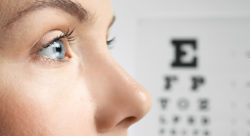Maintaining Eye Health
Protecting your vision is one of the best ways to ensure your eye health throughout life.
 To do this, TDC Eye Care recommends maintaining routine preventative care to help retain and optimize your vision and prevent impairments. Many things, such as getting good nutrition from fruits and vegetables, wearing protective eye wear when playing sports or in the workplace, and seeking proper care in emergencies, can go a long way to ensuring your eye health and vision.
To do this, TDC Eye Care recommends maintaining routine preventative care to help retain and optimize your vision and prevent impairments. Many things, such as getting good nutrition from fruits and vegetables, wearing protective eye wear when playing sports or in the workplace, and seeking proper care in emergencies, can go a long way to ensuring your eye health and vision.
Nutrition
Getting good nutrition from fruits and vegetables can have a positive impact on your eyesight. Many optometrists are expanding their traditional roles to include other areas that affect eye health, such as nutrition. Research has shown that nutrition can impact the development of cataracts and age-related macular degeneration (AMD), which are the two leading causes of blindness and visual impairment among millions of aging Americans. Nutrition may be particularly important given that currently, treatment options after diagnosis for these eye diseases are limited.
Sports
Eye protection should be a major concern to all athletes. Vision, just like speed and strength, is an important component in how well you play your sport.
Your vision is composed of many interrelated skills that can affect how well you play your sport — it’s more than just seeing clearly. However, just as exercise and practice can increase your speed and strength, proper preventative care and routine eye exams can also improve your visual fitness and accuracy.
Schedule your appointment with our optometrist, or one with expertise in sports vision, to assess your unique visual system and obtain recommendations for the proper eyeglasses or contact lenses, or design a vision therapy program that will maximize your visual skills for your sport. In addition, thousands of children and adults suffer sports-related eye injuries annually, and nearly all can be prevented by using the proper protective eyewear. Especially for sports played outdoors, appropriate sunglasses are a must, and some sport-specific designs may even help you improve your game. Ask your optometrist which type is best suited for your favorite sport.
In the Workplace
Eye injuries in the workplace are very common. The National Institute for Occupational Safety and Health (NIOSH) reports about 2,000 U.S. workers sustain job-related eye injuries that require medical treatment each day. However, safety experts and eye doctors believe the right eye protection could have lessened the severity or prevented 90% of these eye injuries. Common eye injuries occurring at work can result from chemicals or foreign objects in the eye and cuts or scrapes on the cornea. Other causes of injuries include splashes with grease and oil, burns from steam, ultraviolet or infrared radiation exposure and flying wood or metal chips.
In addition, healthcare workers, laboratory and janitorial staff, and other workers may be at risk of acquiring infectious diseases from eye exposure. Some infectious diseases can be transmitted through the mucous membranes of the eye as a result of direct exposure to blood splashes, respiratory droplets generated during coughing or from touching the eyes with contaminated fingers or other objects.
The Occupational Safety and Health Administration (OSHA) requires the use of eye and face protection whenever there is a reasonable probability of injury that could be prevented by such equipment. Personal protective eyewear, such as goggles, face shields, safety glasses, or full face respirators must be used when an eye hazard exists. The eye protection chosen for specific work situations depends upon the type of hazard, the circumstances of exposure, other protective equipment used, and individual vision needs.
Click on the providers’ images below to learn more about our TDC Eye Care team.
Providers in this Specialty


